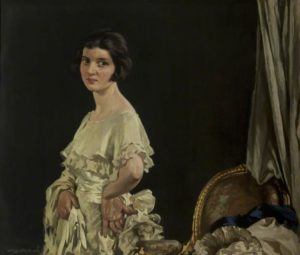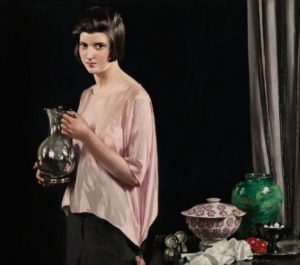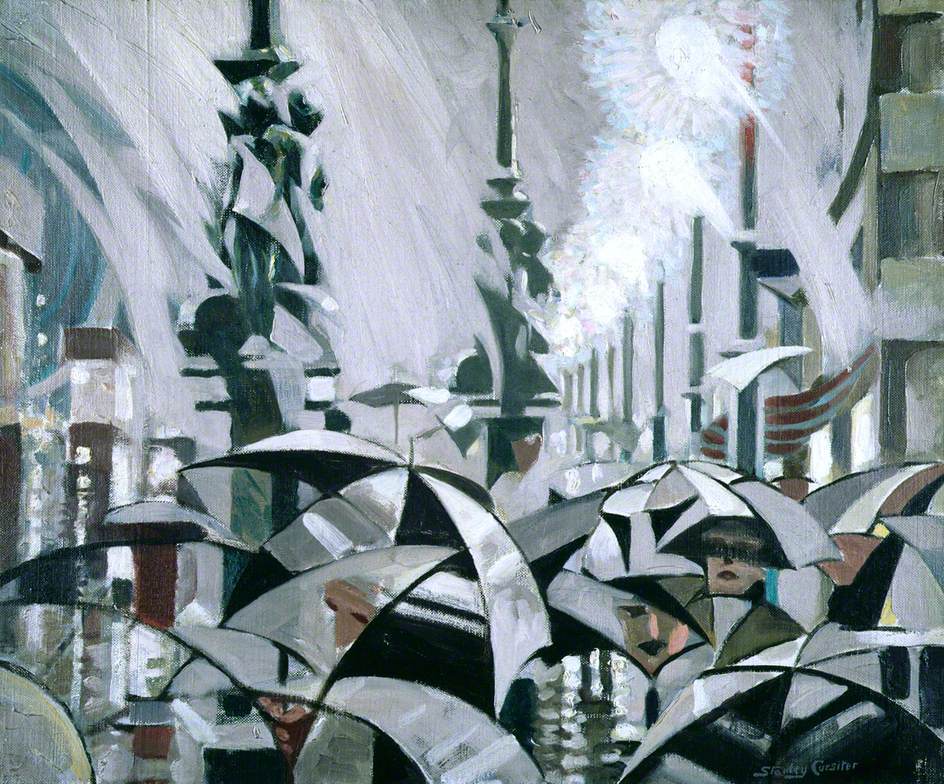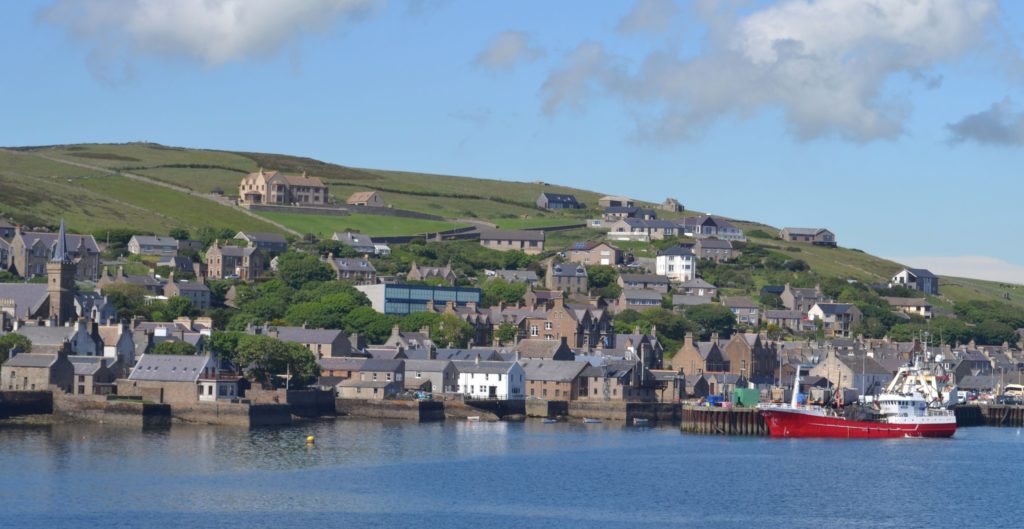
Roberta by Stanley Cursiter, Blackburn Museum and Art Gallery © estate of Stanley Cursiter Photo Credit: Blackburn Museum and Art Gallery
29 July 2023
By Ken Ford, Blackburn Museum and Art Gallery Volunteer
Hanging in the Victorian Gallery at Blackburn Museum and Art Gallery is this portrait by the Scottish artist, Stanley Cursiter. It is entitled ‘Roberta’. Who is she and why was her portrait painted? I had read that he used a model called Poppy Low and had seen another portrait of her so I had assumed ‘Roberta’ was just used as a title and not her real name. However I was wrong!
In the early 1920’s Stanley Cursiter was comminssioned by an Edinburgh art dealer to produce twenty portraits of ‘pretty girls with pretty frocks alongside a vase of flowers, bowls of fruit or something similar’. Cursiter used two different but very similar models: Poppy Low and Roberta Farquharson. So she really is Roberta but it is hard to tell the two of them apart.
Here is another portrait of her alongside one of Poppy and the difference is….Poppy has a longer fringe!

(Model: Poppy Low to the right of the painting) Artist, Self Portrait, Director of the National Galleries of Scotland, with his Wife Phyllis Eda Hourston, and his Model, Poppy Low, Chez Nous, National Galleries of Scotland; @ estate of Stanley Cursiter. Photo Credit: National Galleries of Scotland: Portrait

(Model: Roberta Farquharson) Girl with a Jug, Hunterian Art Gallery, University of Glasgow; @ estate of Stanley Cursiter Photo Credit: The Hunterian Art Gallery, University of Glasgow
Stanley Cursiter was born in 1887 in Kirkwall, Orkney where his father worked in the family grocery business. When his father died Stanley was 10 years old and afterwards he spent a lot of time at the farm of his maternal grandfather. He took a great interest in the countryside and took up sketching the landscape. An impressive painting exists of a coastal scene done when he was just 14.
He wanted to be an architect but the training would have been too expensive for the family. Instead he took up an apprenticeship at a firm of printers and lithographers in Edinburgh where he learned the basic principles of design and attended part-time art classes at the School of Art. He excelled in this exams, coming in the top three in the whole country and was offered a scholarship at the Royal College of Art in London. He went for a few months but decided it wasn’t for him since the emphasis was on becoming a teacher of art – which he didn’t want to be.

Rain on Princes Street; Dundee Art Galleries and Museums Collection (Dundee City Council) @ estate of Stanley Cursiter. Photo Credit: Dundee Art Galleries and Museums Collection (Dundee City Council)
He returned to Edinburgh to complete his apprenticeship during which time he produced and sold many landscape paintings. So successful was he that he decided he could make a living as an artist. After 1910 he experimented with abstract paintings in the style of the Italian Futurists who were influenced by the speed of modern life. This came to a stop in 1914 when war was declared.
He joined the Scottish Rifles and while at training camp he met Phyllis who was to become his wife. They married in 1916 when he had 3 days leave. A week later he was on the Somme where his skills were employed as a map-maker; the system he devised earned him an OBE and the rank of Lieutenant. He didn’t see Phyllis again for 2 years.
On his return they settled in Edinburgh, living in a fine house in Royal Circus where Stanley resumed painting, including his series of ‘pretty girls’ portraits. In 1925 he was appointed as Keeper at the Scottish National Gallery where he set up one of the first in-house picture repair and restoration departments. In 1930 he was promoted to become the Director, a post he held for 18 years. During this time he struggled to find support from the authorities for a Gallery of Modern Art and decided to retire back to Orkney in 1948.

A Farm in Orkney; McLean Museum and Art Gallery – Inverclyde Council; @ estate of Stanley Cursiter. Photo Credit: McLean Museum and Art Gallery – Inverclyde Council
He bought a derelict boathouse in Stromness and converted it into a home and studio but still kept a studio in Edinburgh to produce portraits which were much in demand. Nevertheless his real love was painting views of Orkney, where he said he didn’t have to paint trees! He was appointed the King’s (later Queen’s) Painter and Limner (portraitist) in Scotland and painted two pictures of the Queen on her visits north of the border. He made many contributions to life on the island including designing a chapel and its fittings for the cathedral.
In 1965, aged 78, he was suffering arthritis and couldn’t produce work to his previous standard so he and Phyllis moved into a small cottage on one of the Stromness piers. There he continued to paint, returning to abstract artwork until he died in 1976, one year after his wife.
On a trip to Orkney in 2014, long before I had heard of Stanley Cursiter, I took this photograph from the ferry. Standing out clearly in the centre of the picture is the white cottage on Stromness pier where he spent his retirement.

Orkney. Photo Credit: Ken Ford